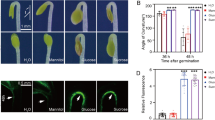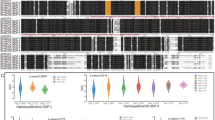Abstract
Sweet cherry (Prunus avium L.) is one of the most economically important fruits in the world. However, severe fruit abscission has brought significant challenges to the cherry industry. To better understand the molecular regulation mechanisms underlying excessive fruit abscission in sweet cherry, the fruit abscission characteristics, the anatomical characteristics of the abscission zone (AZ), as well as a homeodomain-Leucine Zipper gene family member PavHB16 function were analyzed. The results showed that the sweet cherry exhibited two fruit abscission peak stages, with the “Brooks” cultivar demonstrating the highest fruit-dropping rate (97.14%). During these two fruit abscission peak stages, both the retention pedicel and the abscising pedicel formed AZs. but the AZ in the abscising pedicel was more pronounced. In addition, a transcription factor, PavHB16, was identified from sweet cherry. The evolutionary analysis showed that there was high homology between PavHB16 and AtHB12 in Arabidopsis. Moreover, the PavHB16 protein was localized in the nucleus. Overexpression of PavHB16 in Arabidopsis accelerated petal shedding. In the PavHB16-overexpressed lines, the AZ cells in the pedicel became smaller and denser, and the expression of genes involved in cell wall remodeling, such as cellulase 3 gene (AtCEL3), polygalacturonase 1 (AtPG1), and expandin 24(AtEXPA24) were upregulated. The results suggest that PavHB16 may promote the expression of genes related to cell wall remodeling, ultimately facilitating fruit abscission. In summary, this study cloned the sweet cherry PavHB16 gene and confirmed its function in regulating sweet cherry fruit abscission, which provided new data for further study on the fruit abscission mechanism.








Similar content being viewed by others
Data availability
The data that support the results are included within the article and its supplemental files. Other relevant materials are available from the corresponding authors upon reasonable request.
References
Alizadeh Z, Ghasemnezhad M, Sangani MF, Atak A (2023) The effects of high concentration of bicarbonate applications on kiwifruit genotypes with different ploidy levels on some growth parameters of leaves. Turk J Agric For 47(4):436–447. https://doi.org/10.55730/1300-011x.3100
Ariel FD, Manavella PA, Dezar CA, Chan RL (2007) The true story of the HD-Zip family. Trends Plant Sci 12(9):419–426. https://doi.org/10.1016/j.tplants.2007.08.003
Chen W, Chen R, Zhang Y et al (2020) Cloning, characterization and expression analysis of the phosphate starvation response gene, ClPHR1, from Chinese fir. Forests 11(1):104. https://doi.org/10.3390/f11010104
Cheng S, Liu Y, Su L et al (2023) Physiological, anatomical and quality indexes of root tuber formation and development in chayote (Sechium edule). BMC Plant Biol 23(1):413. https://doi.org/10.1186/s12870-023-04427-0
Chockchaisawasdee S, Golding JB, Vuong QV, Papoutsis K, Stathopoulos CE (2016) Sweet cherry: composition, postharvest preservation, processing and trends for its future use. Trends Food Sci Technol 55:72–83. https://doi.org/10.1016/j.tifs.2016.07.002
Du J, Lu S, Chai M et al (2021) Functional characterization of PETIOLULE-LIKE PULVINUS (PLP) gene in abscission zone development in Medicago truncatula and its application to genetic improvement of alfalfa. Plant Biotechnol J 19(2):351–364. https://doi.org/10.1111/pbi.13469
Dwivedi KK, Roche DJ, Clemente TE, Ge Z, Carman JG (2014) The OCL3 promoter from Sorghum bicolor directs gene expression to abscission and nutrient-transfer zones at the bases of floral organs. Ann Bot 114(3):489–498. https://doi.org/10.1093/aob/mcu148
Estornell LH, Agusti J, Merelo P, Talon M, Tadeo FR (2013) Elucidating mechanisms underlying organ abscission. Plant Sci 199–200:48–60. https://doi.org/10.1016/j.plantsci.2012.10.008
Gao Y, Liu Y, Liang Y et al (2019) Rosa hybrida RhERF1 and RhERF4 mediate ethylene- and auxin-regulated petal abscission by influencing pectin degradation. Plant J 99(6):1159–1171. https://doi.org/10.1111/tpj.14412
Gubert CM, Christy ME, Ward DL, Groner WD, Liljegren SJ (2014) ASYMMETRIC LEAVES1 regulates abscission zone placement in Arabidopsis flowers. BMC Plant Biol 14:195. https://doi.org/10.1186/s12870-014-0195-5
GÜNdeŞLİ MA, Kafkas S, Karabiyik Ş, Etİ S, Kafkas NE (2022) Study of anatomical and Acc (1-aminocyclopropane-1-carboxylate) during flower budabscission indicate an important role of alternate bearing. Turk J Agric For 46(3), 292–305. https://doi.org/10.55730/1300-011x.3003
Hewitt S, Kilian B, Koepke T, Abarca J, Whiting M, Dhingra A (2021) Transcriptome analysis reveals potential mechanisms for ethylene-inducible pedicel-fruit abscission zone activation in non-climacteric sweet cherry (Prunus avium L). Horticulturae 7(9):270. https://doi.org/10.3390/horticulturae7090270
Hu G, Fan J, Xian Z, Huang W, Lin D, Li Z (2014) Overexpression of SlREV alters the development of the flower pedicel abscission zone and fruit formation in tomato. Plant Sci 229:86–95. https://doi.org/10.1016/j.plantsci.2014.08.010
Kim J, Chun JP, Tucker ML (2019) Transcriptional regulation of abscission zones. Plants (Basel) 8(6):154. https://doi.org/10.3390/plants8060154
Kumar S, Stecher G, Li M, Knyaz C, Tamura K (2018) MEGA X: molecular evolutionary genetics analysis across computing platforms. Mol Biol Evol 35(6):1547–1549. https://doi.org/10.1093/molbev/msy096
Li C, Ma X, Huang X et al (2019a) Involvement of HD-ZIP I transcription factors LcHB2 and LcHB3 in fruitlet abscission by promoting transcription of genes related to the biosynthesis of ethylene and ABA in litchi. Tree Physiol 39(9):1600–1613. https://doi.org/10.1093/treephys/tpz071
Li C, Zhao M, Ma X et al (2019b) The HD-Zip transcription factor LcHB2 regulates litchi fruit abscission through the activation of two cellulase genes. J Exp Bot 70(19):5189–5203. https://doi.org/10.1093/jxb/erz276
Liao W, Li Y, Yang Y, Wang G, Peng M (2016) Exposure to various abscission-promoting treatments suggests substantial ERF subfamily transcription factors involvement in the regulation of cassava leaf abscission. BMC Genomics 17:538. https://doi.org/10.1186/s12864-016-2845-5
Liao W, Cai J, Xu H et al (2022) The transcription factor MebHLH18 in cassava functions in decreasing low temperature-induced leaf abscission to promote low-temperature tolerance. Front Plant Sci 13:1101821. https://doi.org/10.3389/fpls.2022.1101821
Liu X, Cheng L, Li R et al (2022) The HD-Zip transcription factor SlHB15A regulates abscission by modulating jasmonoyl-isoleucine biosynthesis. Plant Physiol 189(4):2396–2412
Maas C, Werr W (1989) Mechanism and optimized conditions for PEG mediated DNA transfection into plant protoplasts. Plant Cell Rep 8:148–151
Meir S, Philosoph-Hadas S, Sundaresan S et al (2010) Microarray analysis of the abscission-related transcriptome in the tomato flower abscission zone in response to auxin depletion. Plant Physiol 154(4):1929–1956. https://doi.org/10.1104/pp.110.160697
Meir S, Philosoph-Hadas S, Riov J, Tucker ML, Patterson SE, Roberts JA (2019) Re-evaluation of the ethylene-dependent and -independent pathways in the regulation of floral and organ abscission. J Exp Bot 70(5):1461–1467. https://doi.org/10.1093/jxb/erz038
Merelo P, Agusti J, Arbona V et al (2017) Cell wall remodeling in abscission zone cells during ethylene-promoted fruit abscission in citrus. Front Plant Sci 8:126. https://doi.org/10.3389/fpls.2017.00126
Nakano T, Kimbara J, Fujisawa M et al (2012) MACROCALYX and JOINTLESS interact in the transcriptional regulation of tomato fruit abscission zone development. Plant Physiol 158(1):439–450. https://doi.org/10.1104/pp.111.183731
Nakano T, Fujisawa M, Shima Y, Ito Y (2014) The AP2/ERF transcription factor SlERF52 functions in flower pedicel abscission in tomato. J Exp Bot 65(12):3111–3119. https://doi.org/10.1093/jxb/eru154
Nieuwenhuizen NJ, Chen X, Pellan M et al (2021) Regulation of wound ethylene biosynthesis by NAC transcription factors in kiwifruit. BMC Plant Biol 21(1):411. https://doi.org/10.1186/s12870-021-03154-8
Olsson V, Butenko MA (2018) Abscission in plants. Curr Biol 28(8):R338–R339. https://doi.org/10.1016/j.cub.2018.02.069
Patharkar OR, Walker JC (2018) Advances in abscission signaling. J Exp Bot 69(4):733–740. https://doi.org/10.1093/jxb/erx256
Pehlivan N (2019) Stochasticity in transcriptional expression of a negative regulator of Arabidopsis ABA network. 3 Biotech 9(1):15. https://doi.org/10.1007/s13205-018-1542-2
Santiago J, Brandt B, Wildhagen M et al (2016) Mechanistic insight into a peptide hormone signaling complex mediating floral organ abscission. Elife 5:e15075. https://doi.org/10.7554/eLife.15075
Sawicki M, Ait Barka E, Clement C, Vaillant-Gaveau N, Jacquard C (2015) Cross-talk between environmental stresses and plant metabolism during reproductive organ abscission. J Exp Bot 66(7):1707–1719. https://doi.org/10.1093/jxb/eru533
Schmittgen TD, Livak KJ (2008) Analyzing real-time PCR data by the comparative C(T) method. Nat Protoc 3(6):1101–1108. https://doi.org/10.1038/nprot.2008.73
Sharif R, Raza A, Chen P et al (2021) HD-ZIP gene family: potential roles in improving plant growth and regulating stress-responsive mechanisms in plants. Genes (Basel) 12(8):1256. https://doi.org/10.3390/genes1030413
Wei PC, Tan F, Gao XQ et al (2010) Overexpression of AtDOF4.7, an Arabidopsis DOF family transcription factor, induces floral organ abscission deficiency in Arabidopsis. Plant Physiol 153(3):1031–1045. https://doi.org/10.1104/pp.110.153247
Wilmowicz E, Kucko A, Alche JD et al (2022) Remodeling of cell wall components in root nodules and flower abscission zone under drought in yellow lupine. Int J Mol Sci 23(3):1680. https://doi.org/10.3390/ijms23031680
Yi JW, Wang Y, Ma XS et al (2021) LcERF2 modulates cell wall metabolism by directly targeting a UDP-glucose-4-epimerase gene to regulate pedicel development and fruit abscission of litchi. Plant J 106(3):801–816. https://doi.org/10.1111/tpj.15201
Zhang X, Henriques R, Lin SS, Niu QW, Chua NH (2006) Agrobacterium-mediated transformation of Arabidopsis thaliana using the floral dip method. Nat Protoc 1(2):641–646. https://doi.org/10.1038/nprot.2006.97
Zhao W, Baldwin EA, Bai J, Plotto A, Irey M (2019) Comparative analysis of the transcriptomes of the calyx abscission zone of sweet orange insights into the huanglongbing-associated fruit abscission. Hortic Res 6:71. https://doi.org/10.1038/s41438-019-0152-4
Acknowledgements
Not applicable.
Funding
The project was supported by Grants from the National Natural Science Foundation of China (32272649), and the National Guidance Foundation for Local Science and Technology Development of China (2023-009), as well as Guizhou Provincial Science and Technology Plan Project [Qianke Foundation-ZK (2021) General 150].
Author information
Authors and Affiliations
Contributions
XPW and ZLQ designed the research. ZLQ carried out the experiments with the help of QDH, ZW, TT, YH, KY, and GQ. ZLQ collected the experimental data and drafted the manuscript. XPW revised the manuscript. All authors read and approved the final manuscript.
Corresponding author
Ethics declarations
Conflict of interest
The authors declare that they have no competing interests.
Additional information
Publisher's Note
Springer Nature remains neutral with regard to jurisdictional claims in published maps and institutional affiliations.
Supplementary Information
Below is the link to the electronic supplementary material.
Rights and permissions
Springer Nature or its licensor (e.g. a society or other partner) holds exclusive rights to this article under a publishing agreement with the author(s) or other rightsholder(s); author self-archiving of the accepted manuscript version of this article is solely governed by the terms of such publishing agreement and applicable law.
About this article
Cite this article
Qiu, Z., Hou, Q., Wen, Z. et al. Identification of PavHB16 gene in Prunus avium and validation of its function in Arabidopsis thaliana. Physiol Mol Biol Plants (2024). https://doi.org/10.1007/s12298-024-01443-8
Received:
Revised:
Accepted:
Published:
DOI: https://doi.org/10.1007/s12298-024-01443-8




